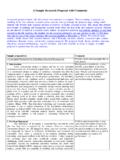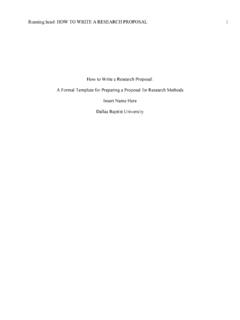Transcription of A Guide To The Abstract - Western University
1 A Guide To The Abstract What is an Abstract ? An Abstract is a brief summary which condenses in itself the argument and all the essential information of a paper. An Abstract allows the reader to survey the contents of a document quickly and decide whether to continue reading. It needs to be dense with information but also readable, well-organized, brief, and self-contained. abstracts are generally 100-250 words, though a thesis or conference Abstract may be up to 400 words. There are no rules for the exact format of an Abstract . This Guide provides samples, below, of the commonly used formats: paragraph style, headings style, and mixed style. A conference paper may have an audience of a few dozen; the audience for a journal paper may be hundreds to thousands.
2 An Abstract , though, has a life of its own in electronic databases around the world. Like a title, it is used by abstracting and information services to index and retrieve articles. Thus, for every person who hears or reads a paper, hundreds will read the Abstract . An Abstract competes for attention in a global ocean of literature it's worth spending some quality time on writing it. What Goes into an Abstract ? For a research paper, an Abstract typically answers these questions: Purpose: What is the nature of your topic/study and why did you do it? Methods: What did you do, and how? Results: What were your most important findings? Conclusions: What can you logically conclude through analysis of your data?
3 Relevance: How do your findings relate to the theory or practice of your field, or to future research? Do you have any recommendations? For a methods paper, an Abstract typically answers these questions: Name: What is the name or category of the method, apparatus, or material? If this is an improved version of an existing method, say so. Purpose: What is the major reason for developing this method? State the purpose in the form for doing X or to do X.. Features: What are its key features, how does it work, or both? Relevance: Why is this method needed? Tests: How was it tested? Evaluation: How well did it work? Tips on Writing an Abstract 1. Write the Abstract last 2. Follow any guidelines you've been given 3.
4 Be accurate 4. Be self-contained 5. Be clear, concise and specific 6. Use signals 7. Emphasize points in proportion to the emphasis they receive in the paper 8. Select key indexing terms Tip : Write the Abstract last An Abstract should be written as the final stage of an otherwise complete paper. Otherwise it will tend to be vague and/or incomplete. You'll hesitate to be too specific, because you don't know yet what your conclusions will be. You'll start writing uninformative sentences like these: X Preliminary results are presented. X Policy implications are discussed. When you are writing for a course deadline or for publication, it's easy to follow this advice. What happens, though, when you want to present a paper at a conference in six or eight months?
5 You are asked to submit an Abstract for consideration by the conference committee. Your acceptance depends on the quality of the Abstract , which is also going to be published in the conference program. Meanwhile, you're still collecting data for your experiment or interviewing stakeholders for your policy analysis. How do you write a precisely detailed Abstract ? Although you may not have the results or conclusions that will ultimately be presented in the paper, you do know your problem, theoretical framework, research problem or questions, and methods. These can form the bulk of the Abstract , with your expectations, appropriately qualified, coming next, and a concluding sentence saying to whom your work will be useful, and why.
6 For a sample, see Case C below. Tip : Follow any guidelines you've been given There are no rules for the exact format of an Abstract . However, if the Abstract is being submitted to a conference, journal, grant agency, or is part of a thesis or dissertation, the organization or department may issue guidelines for abstracts . If so, be sure to follow them precisely. Do not try to improve on their format, or think it doesn't matter if you make minor changes (or even major ones!). Differences from an expected format interrupt the reader's ability to concentrate on the text. When your reader has dozens (or hundreds) of abstracts to choose from, this sort of negative attention does not help your case for acceptance.
7 Tip : Be accurate Make sure the Abstract does the following: it uses the same language as the paper, especially key words and concepts; don't try for variety it includes only information that actually appears in the paper it correctly reflects the purpose and content of your paper for a research report, it states if the study extends or replicates previous research it reports what it is in the body of the paper but doesn't comment on it or make claims ( , This important new theory ; Our study is essential in characterizing the function of this receptor ). Tip : Be self-contained You can't ask your reader to go elsewhere for an understanding of what you say in your Abstract . Therefore, define all acronyms and abbreviations (except standard units of measurement).
8 Spell out names of tests and drugs (use generic names for drugs). define unique terms do not include references. An exception is made for sources whose theory, method or measure is being used. For example, All athletes completed the Movement Imagery Questionnaire (MIQ; Hall, 1983). Tip : Be clear, concise and specific make each sentence as informative as possible, especially the lead sentence include in the Abstract only the most important concepts, findings, or implications the question and what was done can often be written in one sentence: To examine the effect of an imagery intervention on imagery use of elite figure skaters, we required athletes (n=30) to listen to a guided imagery session of a skating element during warm up for six consecutive practices.
9 Avoid sentences that contain no real information (Policy implications are discussed). short sentences are preferable but not required. Avoid clusters of nouns and adjectives they make your sentence shorter but compromise clarity: X Our study found significant bipolar disorder interepisodic phase functional morbidity. Our study found significant functional morbidity in the interepisodic phase of bipolar disorder. if you give a P value, also give data ( , mean SD) and the sample size (n). use active voice and personal pronouns for study objectives: X First, new clinical criteria were attempted to be defined. We first sought to define new clinical criteria. conserve characters: o use digits for numbers unless the number begins a sentence o abbreviate whenever possible ( , vs.)
10 For versus). o give percent change rather than exact data when possible don't waste space by repeating the title don't waste space with promises an Abstract should deliver: X This study will examine pain control at Hospital X. Of the caregivers at Hospital X, 53% actively encouraged epidurals for patients who were hostile or extremely resistant to artificial pain control. Tip : Emphasize points in proportion to the emphasis they receive in the paper If your paper is a proposal, and you have devoted fairly equal sections to background, literature review, and your proposed method, those should be the proportions in the Abstract . If you are reporting on research, the amount of space devoted to results should reflect their importance and level of complexity.


